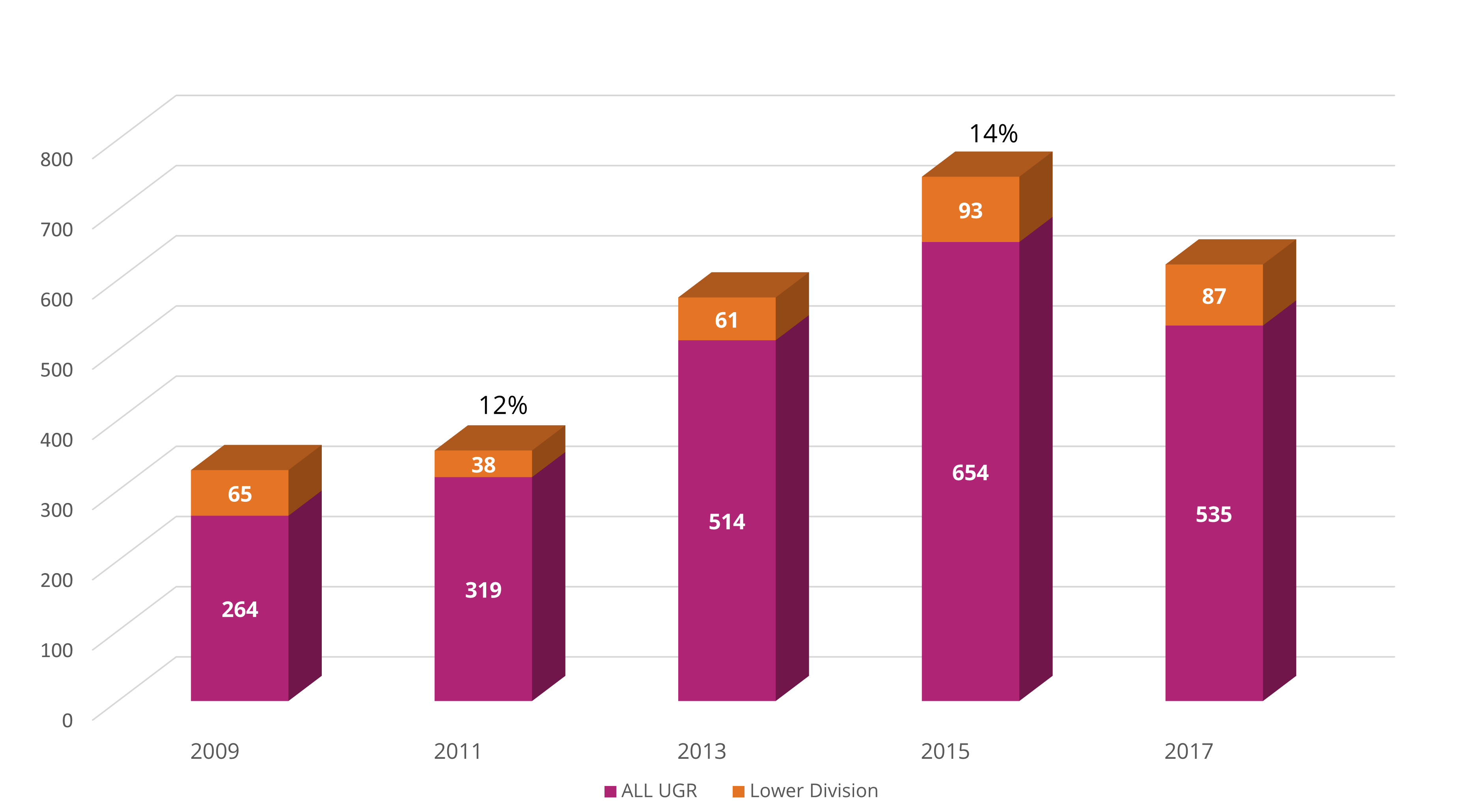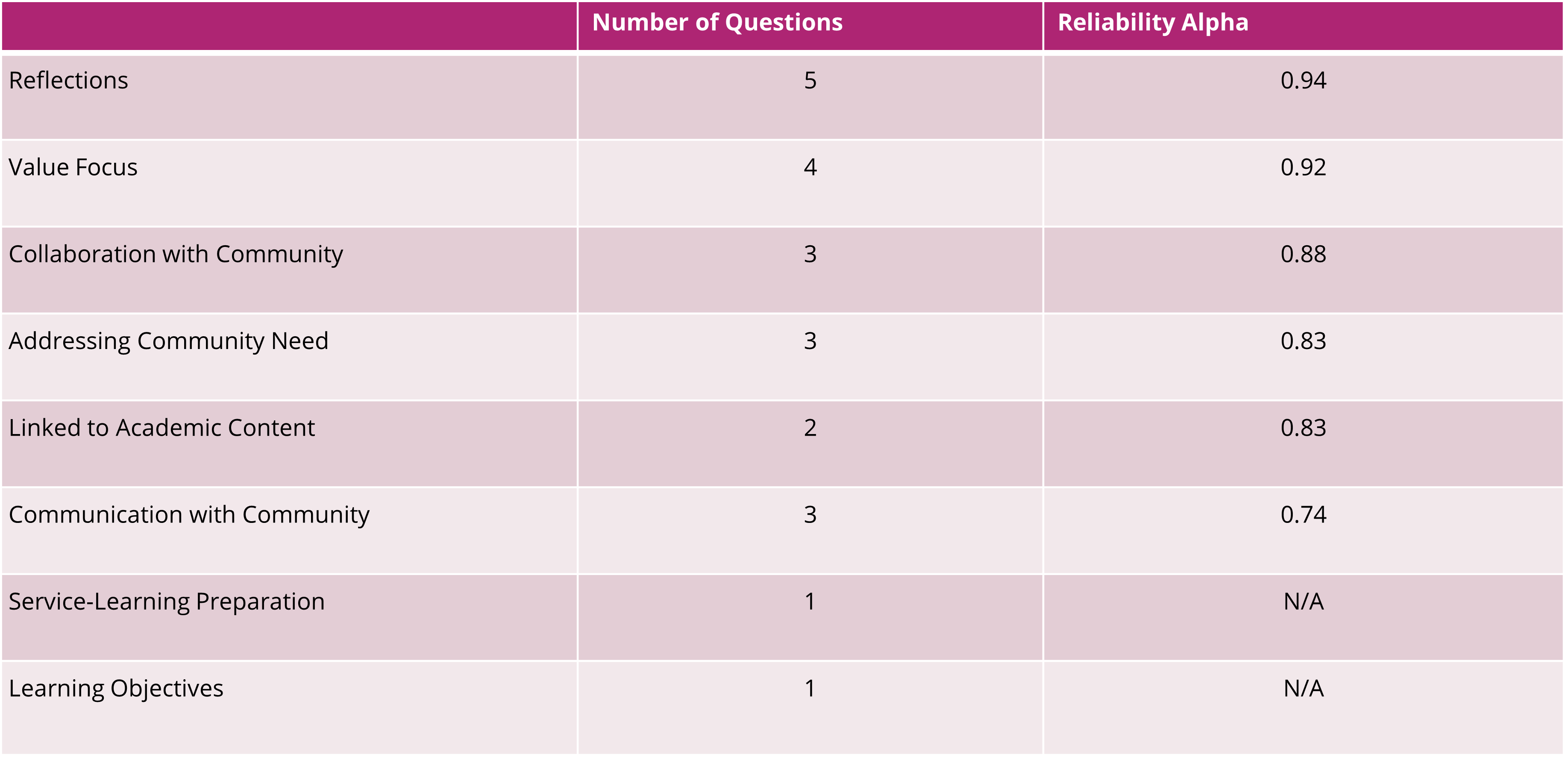Why Study Service Learning in STEM Disciplines?
The CSU believes that service learning can provide engaging and meaningful experiences for our STEM students while actively creating a more skilled STEM workforce. A dynamic process, service learning is a collaborative experience that promotes skills associated with teamwork, community involvement and citizenship. Since 1998, the CSU has seen a 114 percent increase in service-learning courses across all disciplines.
The chart below highlights how service learning in STEM disciplines has developed since the CSU began a systemwide effort in 2010 to increase the number of STEM service-learning courses.

Design & Study Phases
The original research study used a quasi-experimental design and mixed-methods approach to investigate the research questions. Due to a smaller sample size than expected, particularly in the control group, the original data collection efforts were enhanced by adding
secondary data analyses using other CSU students that were not in the treatment group as carefully matched controls. With this new matched group longer term study outcomes were compared.
Study Phases
The study was conducted in four phases beginning in summer 2014 through spring 2018. 
Research Objectives & Questions
Understand the Landscape
- How is service learning in STEM currently being implemented given the vast range of interpretations of service learning?
See Findings
- What are the common underlying elements in service learning implementation? See Findings
- To what degree are the essential elements of high quality service learning present in participating courses?
Determine How the Quality of SL Relates to Student Outcomes
- Does service learning in STEM disciplines have a positive impact on student success in 3 outcome areas: academic achievement, career development, and civic engagement?
See Findings
- Are there differential results with respect to these outcome areas for students depending on the quality of the service-learning course experience?
See Findings
- Does service learning in STEM disciplines promote access to the professional realm for students or bring about meaningful change to the structure of undergraduate training, particularly for underserved populations?
Back to Top ↑
Study Instruments
Multiple measures were used to assess implementation of participating STEM service-learning courses.
Understanding the Essential Elements of Service Learning
Eight essential elements of service learning emerged from the literature, student ratings and initial analysis.
The research team culled the literature on service learning and identified 15 key areas defined by the field such as reflection community need and linkages to learning outcomes. Survey items were developed for faculty and student surveys with the goal of statistically combining items into a smaller number of scales and determining which items were strongly related. Because no clear pattern emerged, the research team reviewed the survey items again and statistically tested whether item groupings represented distinct components of quality. Six components of quality were initially identified.
Student ratings were then used to develop internal consistencies for components that had two of more questions, determining the relationship between the items that belonged together. A reliability analysis was performed to determine multiple items for most categories outlined in the table below.
Service Learning Elements & Reliability Coefficients
Future work would require researchers to develop more items in each category to increase the consistency of each element. See
Michigan Journal of Community Service Learning article (Vol 26, Issue 2, Summer 2020) for more information.

Study Measures: Faculty & Student Survey Instruments
Student Civic Engagement and STEM Career Interest Survey included the
Civic Engagement scale (Doolittle & Faul, 2013) and
STEM Career Interest scale (ITEST Program 2010).
Other Measures
- Student academic achievement data from Institutional Research (IR) offices including student achievement data related to grades, retention, graduation, and student demographics.
- Course syllabi: Each faculty member was required to submit a copy of their syllabus for each treatment course. These syllabi were coded by a service-learning content expert according to the
Fundamentals of Service-Learning Course Construction (Heffernan, 2001).
- 1-Year follow-up of student civic engagement attitudes & behaviors; career interest and awareness in STEM
Back to Top ↑
Study Samples
A descriptive overview of participants in the study are outlined below.
Campuses:
- CSU Dominguez Hills
- Fresno State
- Cal State LA
- CSU Monterey Bay
- CSU Northridge
- Cal Poly Pomona
- Sacramento State
- San Jose State
- CSU San Marcos
- Stanislaus State
STEM Disciplines In the Study
The National Science Foundation's definition of what constitutes as STEM was used to recruit faculty participants; however, CCE does not include social sciences in its definition.
Faculty & Student Participants
47 faculty members were recruited, some of whom taught multiple sections of the same course during the same term; therefore, faculty and student data across courses were combined, or clustered together.
Of the total number of student respondents, 2,065 were unique students (i.e., participated in the study one time), about 80% of whom were in the treatment group.